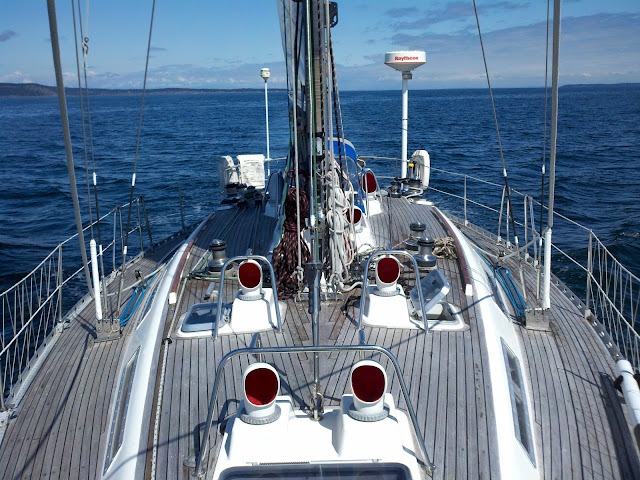The lighter area needs two more coats. Hopefully this stuff works. I have some touch up spots on the caulking. Amazing what you see when you get up close and paint something. I missed all sorts of bungs and the like. Had to stop multiple times and drill and fill holes. Some areas are too far gone for anything so I filled them with this flexible epoxy and covered that with the TeakGuard and supposedly that will help keep the UV from damaging the epoxy. The teak is glued down so securely that I can't replace individual board without tearing up everything around the bad board. Collateral damage I suppose you could call it. Screw it!
I got stopped a couple times by people on the dock as they were walking by. They all commented on how great it looks. Here is a shot of what they did look like.
 |
| Don't let the nice silver look fool you. Underneath all that silver decking is thousands of screws that are begging for release. Mold is everywhere on this deck. Eating the wood slowly. |
 |
| See all the dark splotches? Mold. Eating my teak. Die mold! DIEEE!!!!!!! |
While waiting for the coatings to dry, I tore into the bilge pump and the hot water heater exchange loop. God, what a pain that job was/is. The wiring from the factory is great. All of it running in it's own conduit and making sense. Then there is the mess from the previous owner.
I could take pictures. I tried even but I couldn't. Just couldn't. No sense in letting that abomination of wiring live any longer. In real life or in cyberlife. That and my tears made it hard to hold the camera.
 |
| Who knew this cute little thing could cause me so much misery? |
 |
| Oh no, you didn't misread my price. I am four hundred frickin' dollars!! And I AM LOUD!!! |
The manual says it is good for 480gph but my pump is pumping much slower than that. Could it be the wiring? No way. On my boat? Cast that thought aside. The power for this 9lb behemoth ran from the panel (I think) to the float switch, then spliced into the original bilge wiring IN THE BILGE without any protective coating whatsoever. The connection crumbled. I won't even tell you about the ground.
 |
| I found three of these in the bilge. They scampered away before I could get them! I wonder what they eat? |
The old pump is also located out of the bilge (a good thing) but takes up storage space (bad thing). I decided to get rid of the old evil float switch and install that new RULE with the water sensor built in. The wee little RULE turns itself on every 2.5 minutes for a brief moment and spins it's impeller. If the impeller meets resistance, it stays on and pumps out the water. If there is too much resistance from a heavy liquid such as oil, it won't pump. I think it is brilliant. Hope it doesn't make a bunch of noise when it does it's check though.
The little RULE is a 500 GPH pump and not meant to stop a huge ingress of water but only for minor clean ups in the bilge. For emergencies, I'll have this installed
 |
| Or something like it. |
The switch for the bilge pump is located under the nav station and under the windlass on/off selector. The bilge pump switch ground ran from the switch up to the windlass panel and was connected to the on/off indicator light and then ran down to an unknown tangle of wires. That tangle turned out to be the night light ground wire to the light. Not a ground but a ground wire for the light. There was no ground. Yet the night light worked along with the indicator light on the windlass but the light on the RULE switch did not work. I bought a combo positive/negative busbar and installed in by the fridge/freezer compressors. I then chased everything down that I could (still some mystery wires) and grounded everything properly along with supplying good power to the busbar.
The hoses for the hot water heater actually were not that bad to run. I changed the fittings on the heater to 90° to help not bend the hoses so much. I just have to flush the system out and it'll be done. For now.





No comments:
Post a Comment